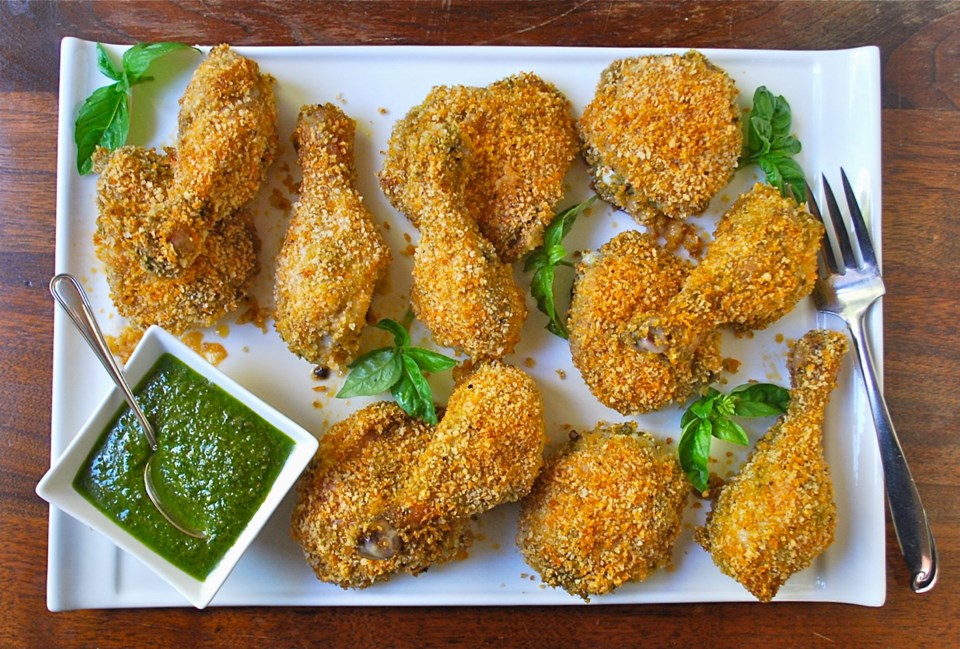I planted basil this year. It grew well, and during the summer I’ve regularly snipped some to use in a range of dishes. I still have tons of basil left, so with fall just around the corner, I recently harvested most of what was left and made pesto.
The Dictionary of Italian Food and Drink says the Italian word pesto means “pounded.” That’s because, traditionally, pesto, the vibrant green sauce, is made by pounding and mixing the basil and other ingredients with a mortar and pestle.
Marcella Hazen, in her book The Classic Italian Cookbook, says everyone should make pesto with a mortar and pestle at least once, because of the greater character of its texture and its richer flavour.
But she says pesto made with a machine, such as the food processor I used, is still so good that we should enjoy it with a clear conscience whenever we don’t have the time or patience to make it make by hand.
And that is especially true when turning large amounts of basil into pesto, as I did.
I processed four cups of loosely packed basil leaves with some garlic, freshly grated Parmesan cheese, pine nuts and extra virgin olive oil.
In my recipe, I give you the option to use less-expensive almonds or walnuts instead of pine nuts, to add richness to the pesto.
Once it’s made, you can keep the pesto in a jar in the refrigerator, or freeze it. See recipe method for details.
Pesto can add a bright green colour and garlicky herbaceous flavour to all sorts of foods. Swirl it into soups, pasta sauces, egg dishes and salad dressings, toss and flavour grilled vegetables with it, spread it on a pizza or sandwich, or use it in marinades for fresh cheeses, olives, fish and meat.
Pesto can also be used to flavour something baked, such as today’s pesto Parmesan-crusted chicken. For a fine, late-summer meal, I served the chicken with a tomato salad, sautéed zucchini and boiled miniature potatoes.
Pesto Parmesan Crusted Chicken
These juicy pieces of baked chicken are coated with a golden, crispy panko crust that is richly flavoured with pesto and freshly grated Parmesan cheese.
Preparation time: 30 minutes
Cooking time: 50 to 55 minutes
Makes: four to six (two to three pieces each) servings
1 1/3 cups panko (see Note)
1/3 cup freshly grated Parmesan cheese (not the dried powdered type)
1/2 tsp smoked paprika
1/2 tsp salt
1/2 tsp freshly ground black pepper, or to taste
1/4 cup mayonnaise
3 Tbsp pesto (see recipe below)
6 medium to large chicken drumsticks (see Eric’s options)
6 medium to large chicken thighs
Combine the panko, cheese, paprika, salt and black pepper in a pieplate or other wide, sided dish. Combine mayonnaise and pesto in a bowl large enough to hold the chicken. Preheat oven to 375 F. Line a large baking sheet with parchment paper.
Add the chicken to the pesto/mayonnaise mixture and toss and evenly coat each piece.
Now coat each piece of chicken in the panko mixture, gently pressing it on to help it adhere. Set the coated chicken on the baking sheet.
Bake chicken in the middle of the oven 50 to 55 minutes, or until cooked through and juices run clear.
Note: Panko are coarse breadcrumbs sold at most supermarkets, often in the Asian foods aisle.
Eric’s options: If desired, you could remove the skin from the chicken before coating it.
Pesto
Bright green, basil-rich pesto you can add to all sorts of dishes, such as salads, pasta, pizza and the chicken recipe above.
Preparation time: 10 minutes
Cooking time: None
Makes: About 1 cup
4 cups fresh basil leaves, loosely packed (see Note)
3 medium to large garlic cloves, sliced
1/3 cup pine nuts, slivered almonds or walnuts pieces
1/2 cup freshly grated Parmesan cheese (not the dried powdered type; see Eric options)
3/4 cup extra virgin olive oil, plus more, if needed
Place all ingredients, except oil, in a food processor and pulse until chopped. Add the oil and process until well blended. Add a bit more oil if you find the pesto too thick. Refrigerate the pesto in a tightly sealed jar with a skim of olive oil on top. It will keep at least a week. The pesto could also be frozen in ice-cube trays, unmoulded and kept frozen in freezer bags or containers until needed.
Note: When measuring the basil, I pressed down on the leaves, loosely packing them, as you see in the photo.
Eric’s options: For even more flavour, you could add 2 Tbsp of sharp-tasting grated pecorino Romano cheese to the pesto when blending it with the Parmesan.
Eric Akis is the author of eight cookbooks. His columns appear in the Life section Wednesday and Sunday.



